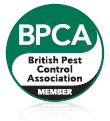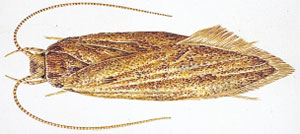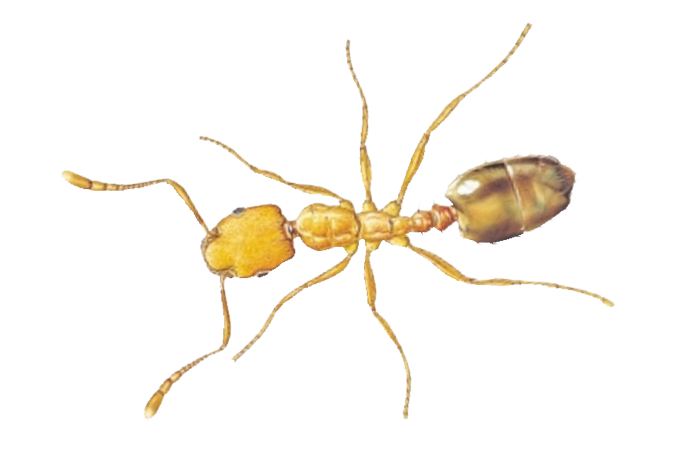- Pest Control Belfast
- County Antrim Pest Control
- Electric Fly Killer Machines
- Air Sterilisation
- Odour Control Products

Belfast | N'Ards
Belfast: 028 9079 6026
N'Ards: 028 9181 8313
M: 07968 155703
Stored Product Pests
- Home
- /
- Stored Product Pests
Stored Product Pests
Moth larvae can cause considerable damage to stored goods by feeding or by contamination with their own products, e.g. webbing and frass. Adult insects are not responsible for damage as they either feed on liquid food and water or do not feed at all. The larval by-products, webbing and frass, are a particular problem. Webbing can entirely coat commodities and may be responsible for blocking machinery and ducts. The problem is exacerbated when webbing becomes mixed with frass, food and general debris.

Warehouse Moth
A major pest of warehouses and, more recently, retail premises. This species will infest cereals, fruit, shelled nuts, cocoa beans, fish, spices and tobacco. In the case of tobacco, “sweet” varieties are preferred and entire interveinal leaf areas may be destroyed. Moth infestations are especially serious where wheat and flour are stored in bulk, although they seldom infest goods which are stored in silos.
Tropical Warehouse Moth
A particular problem in dried fruit and nuts, although this moth will attack cereals, oil seeds and chocolate products.
Mediterranean Flour Moth
Larval webbing can cause serious blockages in provender mills. The larvae eat holes in sifting silks and may also reach the mill’s finished products.
Indian Meal Moth
Another species which is a particular problem of the fruit-drying industry. It will also attack cereals, oil seeds and shelled nuts. Larval webbing may occasionally reach problem proportions.
Rice-Moth
This moth will attack grain (especially rice), oil seeds, cocoa beans, dried fruit, spices and beverages.
Brown House Moth/White-Shouldered House Moth
Both species attack a wide variety of materials including cereals, cereal products, textiles, leather and cork. The Brown house moth tends to scavenge whilst the Whiteshouldered house moth is generally found infesting food.
Common Clothes Moth
Attacks animal products, for example wool, fur, skins and leather. Fibres are bitten off and the loose ends discarded, thus destroying much more commodity than is consumed.
Control
The method and timing of control measures against moths, depends upon the species involved. The larvae are frequently difficult to reach because they are concealed in foodstuffs or the fabric of buildings and may be obvious only when they migrate.
Assessment of infestations
Adhesive traps are used for trapping stored product moths. Attractant capsules containing a pheromone are attached to a sticky surface on which the moths are caught and which is partially protected from the environment. The trap is then suspended ca 2-3 m above the floor. They perform best in locations which are not dusty. Alternatively funnel traps may be used. These are usually constructed of plastic and incorporate a funnel system leading to a retaining chamber in which moths are trapped and killed using a toxicant strip, water or detergent. They incorporate a pheromone lure and are particularly useful in dusty locations. The simplest traps are a dish of water containing a little detergent. Whatever system is employed adequate records must be kept.
(A) Hygiene / Mangement
This is important in order to avoid conditions suitable for the development of moth infestations. Warehouses should be constructed so as to ensure maintenance of correct storage conditions and allow easy cleaning. Cracks and crevices which might serve as harbourages should be kept to a minimum. Stacks of commodities should be neatly arranged above the floor on pallets, with a gap between stacks to allow for ventilation, regular inspection, cleaning and treatment with insecticides if necessary. Good packaging is particularly important to prevent entry of larvae.
Spillages should be removed promptly, and infested goods dealt with immediately either by fumigation or destruction. Uncontaminated products should not be stored in the vicinity of infested materials.
In the case of the house and clothes moths, fabrics should be regularly inspected and cleaned, and alternative breeding sites, for example birds’ nests, removed if possible. It should be remembered that soiled fabrics make a more acceptable diet to these insects than clean ones.
(B) Insecticidal control
In order to obtain the best results, insecticidal control measures should be integrated with good hygiene.
More Information – Moths PDF Factfile















